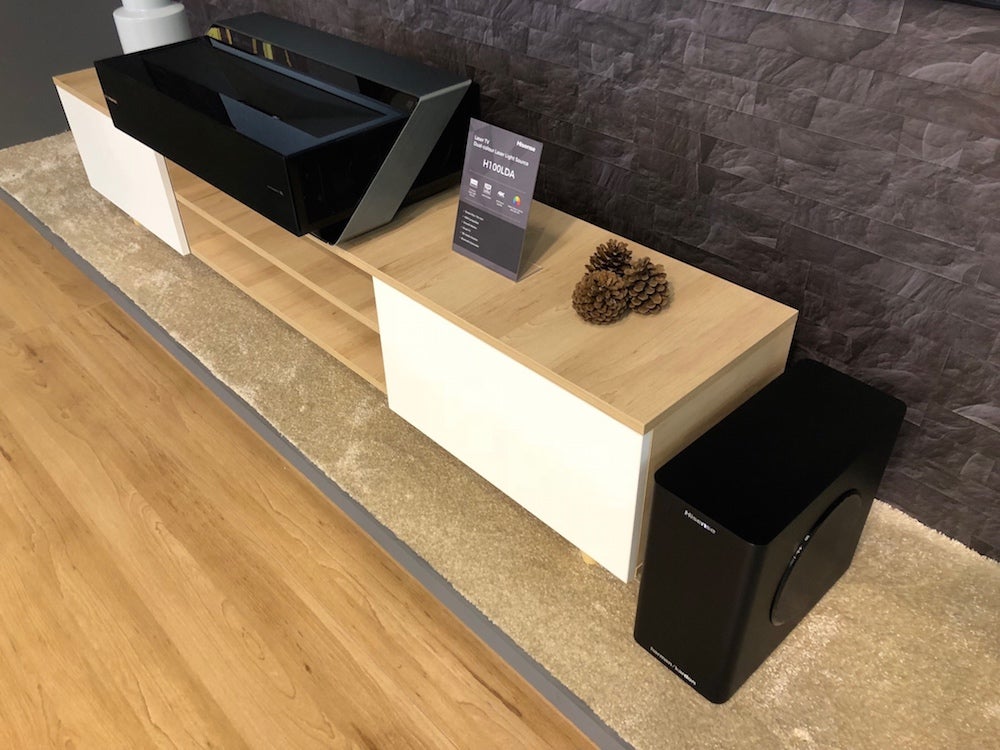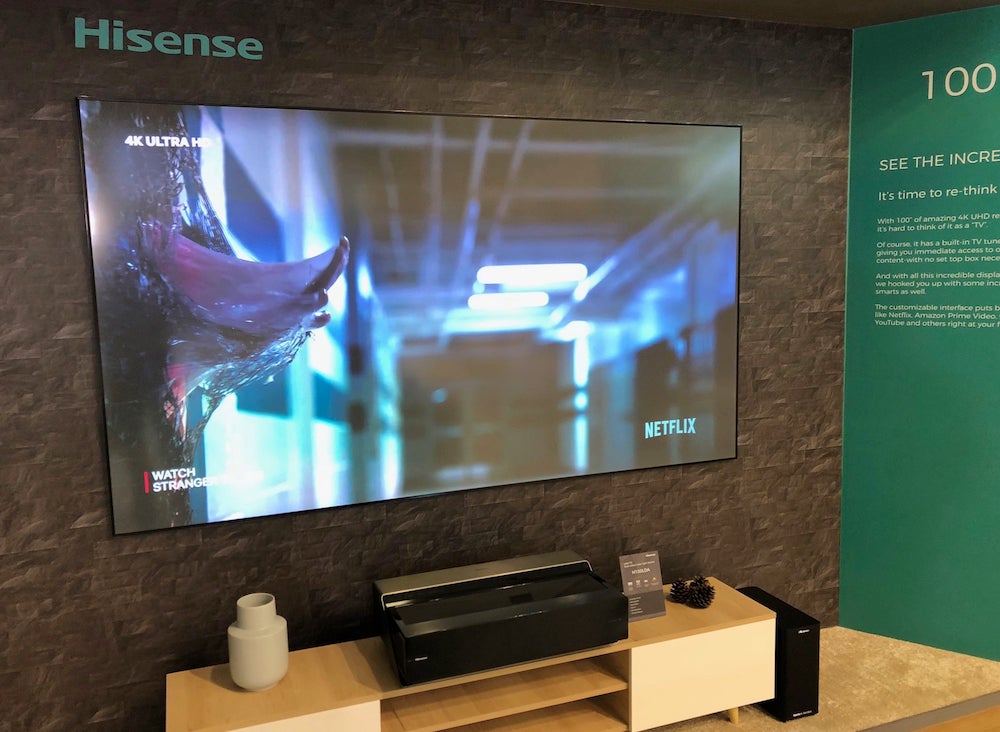Hisense H100LDA Laser TV – First Look
The Hisense H100LDA isn’t exactly your typical TV. For a start, it has a 100-inch screen. It also uses a laser to light its pictures, rather than the usual LCD or OLED technology. Finally, it isn’t really a TV. It’s a projector – but then it’s no ordinary projector either…
Watching visitors approaching the H100LDA on the show floor of IFA 2018 in Berlin is pretty entertaining. Time and again I’ve seen people walk up to the huge screen, realise they’re not looking at a normal TV screen, and then look up, trying to find the projector they presume is responsible for the pictures. Finally, they smile as they realise the source of the pictures is actually right under their nose.
The HD100LDA uses an ultra-short-throw projector that you can place on a sideboard just inches away from a rigid 100-inch screen on your wall, so that you end up with what feels more like a huge, skinny TV screen rather than typical projector system.
This isn’t a wholly new idea. The Sony VPL-VZ1000ES projector is designed to do essentially the same thing, as does the Epson EH-LS100. Optoma does something similar, too, with its combination of an ALR100 screen and Optoma GT5000 short-throw projector.
However, the Hisense H100LDA goes beyond any other solution in the completeness of its TV ambitions.
For starters, the projector is a laser-based, single-chip ‘4K’/HDR-capable DLP system. The laser matters when you’re trying to pitch a projector as a TV – laser lighting is generally much more capable of combatting ambient light than traditional projector lighting systems. The 4K resolution matters, too, since pretty much any big-screen TV you might buy these days will have a 4K resolution.
The H100LDA also ships with a rigid 100-inch screen included in the £10,999 package. What’s more, the screen uses lenticular technology on its surface to subdue the impact of ambient light and reflections – key for any wannabe daylight projector solution.
Unusually for a projector, the H100LDA includes both a TV tuner, Wi-Fi network connectivity, and built-in apps for Netflix, Rakuten, YouTube, Amazon Prime and even Freeview Play.
Last but certainly not least, Hisense even provides a built-in sound system. A pair of 10W stereo speakers designed by Harman Kardon are fixed to the rear of the main laser projection unit, while a decent-sized subwoofer pumps out 60W of bass.

The H100LDA features a stereo speaker system attached to the back of the projector’s body, plus a powerful separate subwoofer.
First impressions of the H100LDA are mixed. Hisense had bravely opted to simply set one up on its open IFA stand, under all the usual harsh show lighting – and right alongside a collection of LCD TVs.
And it was clear right away that the H100LDA’s pictures didn’t look anywhere near as bright and intense under such lighting conditions as those of any of the TVs. Dark areas, too, tended to look rather silhouetted and hollow as the ambient light inserted itself between the light coming out of the projector and that hitting the screen.
The darkness of the HD100LDA’s pictures was almost painful, actually, when I approached it from the side. Happily, though, this turns out to be a viewing angle limitation caused by the technology the screen uses to suppress reflections and ambient light. Sit right in front of the screen, and the picture looks far brighter.
The sheer scale of the H100LDA’s pictures versus the TVs is immense, too. More cinema than TV. And when you start to think about its combination of image size and convenience versus monster TVs, and its bright room potential versus normal projectors, the H100LDA starts to make sense.
The longer I sat on Hisense’s IFA stand watching the H100LDA do its thing, the more I appreciated it. Its pictures really are bright enough to be watchable and engaging, despite IFA’s bright lighting. The screen did well at suppressing reflections from strong, direct light sources scattered around the Hisense stand too.
So while direct sunlight will still be an issue in living room setups, down-firing lighting and general ambient light should be handled pretty well. Bright colours still enjoyed a decent amount of pop and vibrancy, despite the ambient light with which the system was having to compete, and I was impressed by the sharpness and detail in the 4K images.
It’s important to stress that single-chip DLP projectors don’t deliver a truly native 4K performance in the way that, say, Sony’s 4K projectors do. However, they can still deliver greater sharpness and detail than a mere HD projector. And that seems to be born out by the H100LDA on show at IFA, which while not providing the crispest, most textured 4K image I’ve seen, looked a clear step up from HD.
The sharpness looked impressively right across the screen, too, with seemingly no trace of the softness or focus errors in the picture’s corners and edges sometimes seen with ultra-short-throw projectors.
One final strength of the H100LDA’s IFA showing was that its screen seemed pleasingly free of the sort of shimmering effect over bright areas that specialist ‘daylight’ screen designs sometimes suffer.
While the H100LDA’s pictures withstand ambient light well for a projector system, when you’re viewing its screen from dead on, the system’s brightness and contrast doesn’t get close to the sort of punch and intensity you’d see from a decent big-screen TV. Especially where high dynamic range pictures are concerned.
Clearly, you couldn’t get a 100-inch TV for anything close to the H100LDA’s £10,999 price tag. Although you can get the 77-inch LG C8 OLED TV for £7000; Sony is saying that its 75-inch Sony ZF9 will cost £4999; and Hisense’s own ultra-bright Hisense 75U9A costs only £3500.
One final concern was the appearance of a strange grey seam just under a centimetre high appearing across the image’s centre during dark scenes (although it’s typically only visible during off-axis viewing). This doesn’t appear to be a physical seam in the screen, however, so my hope is that it was just a blemish of the much-used demo sample Hisense was showing at IFA.
There was no possibility at IFA to test the eye-catching and promising audio system supplied with the H100LDA’s laser projector. But rest assured, we’ll do so – as well as testing the promising pictures in a wider range of lighting conditions – in the full review we’re hoping to deliver in the coming weeks.
The post Hisense H100LDA Laser TV – First Look appeared first on Trusted Reviews.


Boughts supplies replacement parts for general consumer electronics like TV Remote and other TV accessories. Boughts has a wide range of Original TV Stands for all Brands of Televisions. Visit our website (https://boughts.com) to place your order.
ReplyDeleteTV Remote Control for HISENSE 32H3E Television